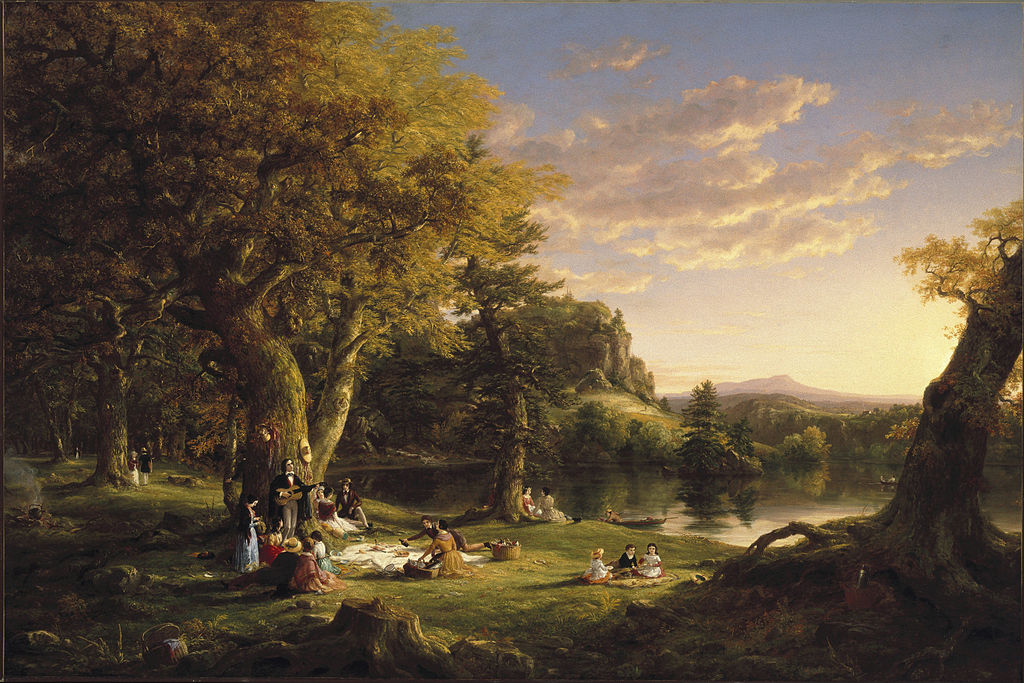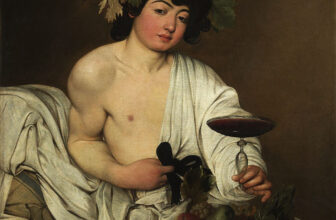
A Pic-Nic Party Painting by Thomas Cole
Symbolism, Meaning, and Artistic Legacy
Thomas Cole, often regarded as the father of the Hudson River School, is widely celebrated for his landscape paintings that blend natural grandeur with moral and philosophical undertones. While he is best known for epic narrative cycles such as The Course of Empire and The Voyage of Life, one of his lesser-known yet profoundly telling works is “A Pic-Nic Party”, painted in 1846.
At first glance, A Pic-Nic Party seems to present a cheerful, almost idyllic scene , a group of elegantly dressed people enjoying a day in nature. However, under Cole’s brush, nothing is ever as simple as it appears. This painting, like much of his oeuvre, is rich in symbolism, cultural critique, and spiritual reflection, offering a layered narrative that explores the intersection between humanity and the natural world.
This article offers an in-depth exploration of A Pic-Nic Party, examining its visual content, symbolic meaning, context within Cole’s broader work, and its current location. We’ll also discuss what type of art it represents and how it fits into the broader movements of its time.
What is “A Pic-Nic Party” Painting by Thomas Cole All About?
Completed in 1846, A Pic-Nic Party is one of Cole’s final works, created shortly before his untimely death in 1848. The painting measures roughly 40 x 60 inches and was commissioned by Charles Nicoll Talbot, a British aristocrat and art collector. Unlike Cole’s grand allegorical works, this piece seems, on the surface, to depict a more relaxed, light-hearted moment , a group of finely dressed men and women having a picnic in a natural, somewhat remote setting.
The setting is lush and dramatic, featuring rocky terrain, expansive skies, distant waterfalls, and towering mountains. The human figures are small in comparison to the grandeur of the landscape , a recurring motif in Cole’s work that emphasizes the sublime power of nature over human endeavors.
Despite its cheerful title, the painting is not a celebration of leisure. Instead, it subtly critiques the increasing trend of aristocratic and bourgeois intrusion into the natural world, a phenomenon that was gaining popularity in both Europe and America during the mid-19th century. The title itself , A Pic-Nic Party , carries a certain irony, juxtaposing the mundanity of a fashionable social activity with the profound, almost sacred beauty of the wilderness.
What is Happening in “A Pic-Nic Party” Painting by Thomas Cole?
The composition of A Pic-Nic Party is carefully arranged. In the foreground, a group of men and women, dressed in formal 19th-century attire, engage in various leisurely activities: reclining, chatting, and partaking in a picnic. One can see parasols, baskets, and flowing dresses , all indicators of a genteel lifestyle transplanted into a rugged environment.
However, the human figures occupy a relatively small portion of the canvas. The real visual focus lies in the landscape: towering rock formations, dense forested cliffs, and a shimmering river or waterfall in the background. The sky is dynamic, with clouds that suggest both serenity and the potential for storm. The juxtaposition of human calm and natural drama implies a kind of tension , a contrast between the controlled, artificial world of society and the untamed, unpredictable world of nature.
In the midground, there is a dramatic drop-off , a steep cliff that seems almost perilous. This introduces an element of danger and unpredictability into an otherwise composed scene. One gets the sense that this picnic party, despite their ease, is out of place, teetering on the edge of an environment that could turn hostile at any moment.
Symbolism and Interpretation of “A Pic-Nic Party” by Thomas Cole
1. Nature vs. Civilization
One of the most prominent themes in Cole’s work is the conflict between nature and civilization. In A Pic-Nic Party, the finely dressed partygoers represent the encroachment of civilization into the wilderness. They bring with them not only their belongings but also their values, aesthetics, and a desire to tame or consume the wild landscape.
Cole often expressed concerns about industrialization and the degradation of the American wilderness. In this painting, the natural world is still dominant , majestic, sublime, overwhelming. But the presence of the party suggests that this is changing. The scene serves as a metaphor for human intrusion into a sacred space, hinting at environmental and moral consequences.
2. The Sublime
The vastness and dramatic elements of the landscape align with the concept of the sublime , a term from Romantic philosophy that refers to experiences that are both awe-inspiring and humbling. Cole uses the sublime to contrast the petty concerns of high society with the eternal and often indifferent forces of nature. This theme resonates with the writings of Edmund Burke and Immanuel Kant, both of whom influenced 19th-century artists and thinkers.
3. Spiritual Allegory
Cole often imbued his works with spiritual undertones. Nature, in his view, was not merely scenery but a reflection of the divine. The painting might be seen as a commentary on how society’s increasing secularism and materialism were distancing people from this divine connection. The cliffs, the sky, and the untouched waterfall might symbolize purity and spiritual depth , qualities that the picnic-goers, in their frivolity, fail to recognize.
4. Transience and Vanity
There is a sense of ephemeral pleasure in the way the figures are painted , a fleeting moment of joy set against the enduring presence of nature. This contrast highlights the vanity and transience of human life. Just as the picnic will end and the people will leave, so too do human endeavors fade with time, while the natural world remains , sometimes scarred, sometimes triumphant.
What Type of Art is “A Pic-Nic Party”?
A Pic-Nic Party is an example of Romantic landscape painting, deeply rooted in the Hudson River School tradition. This artistic movement, founded by Cole in the early 19th century, was characterized by grand depictions of the American wilderness, often infused with moral, philosophical, and nationalistic themes.
Key characteristics of this style evident in A Pic-Nic Party include:
Emphasis on natural grandeur
Sharp contrasts between light and shadow
A spiritual or moral dimension
Realistic yet idealized portrayals of nature
Tiny human figures dwarfed by vast landscapes
However, this particular painting also carries echoes of satirical portraiture and genre painting, especially in its depiction of upper-class leisure. It walks a fine line between admiration of natural beauty and critique of human vanity, making it a multi-genre work with layered intentions.
Where is A Pic-Nic Party Painting by Thomas Cole Located Today?
Today, A Pic-Nic Party resides in the The Thomas Cole National Historic Site, located in Catskill, New York. This site was once the home and studio of the artist and now serves as a museum dedicated to his life and work.
The painting is part of the institution’s permanent collection and is occasionally included in curated exhibitions that explore the evolution of American landscape art. Visitors can view it alongside other works by Cole and his contemporaries, providing a rich context for understanding the values and anxieties of 19th-century America.
A Masterpiece of Subtle Dissent
A Pic-Nic Party by Thomas Cole is far more than a picturesque scene. It is a coded critique, a philosophical musing, and an artistic masterstroke that challenges viewers to reflect on their relationship with nature, society, and spirituality.
Cole’s genius lies in his ability to communicate profound ideas through deceptively simple compositions. What might initially appear as a scene of relaxation becomes, upon closer inspection, a meditation on human vanity, a warning about environmental degradation, and a celebration of nature’s enduring power.
As we face our own 21st-century challenges related to climate change, overconsumption, and the loss of natural spaces, A Pic-Nic Party remains remarkably relevant. It reminds us that true harmony with nature requires more than appreciation , it demands respect, humility, and a willingness to see ourselves not as masters of the earth, but as its temporary guests.
References and Further Reading
Avery, Kevin J. American Drawings and Watercolors in The Metropolitan Museum of Art: A Catalogue of Works by Artists Born Before 1835.
Noble, Louis L. The Life and Works of Thomas Cole.
Ferber, Linda S. The Hudson River School: Nature and the American Vision.
Thomas Cole National Historic Site: https://thomascole.org
If you’re ever in Catskill, NY, a visit to Cole’s home and studio offers not only a chance to see A Pic-Nic Party in person but also a deeper understanding of the man who helped shape the soul of American art.




